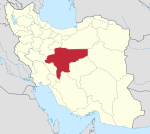New Julfa
| New Julfa Նոր Ջուղա | |
|---|---|
|
Courtyard of the Holy Savior Cathedral, and the Museum of Khachatur Kesaratsi. | |
| Coordinates: 32°38′11″N 51°39′21″E / 32.6363°N 51.6557°E | |
| Country | Iran |
| City | Isfahan |
| Counties | Isfahan County |
| Province | Isfahan Province |
| Settled | early 17th century |
New Julfa (Persian: نو جلفا – Now Jolfā, جلفای نو – Jolfā ye Now; Armenian: Նոր Ջուղա – Nor Jugha) is the Armenian quarter of Isfahan, Iran, located along the south bank of the Zayande River.
Established and named after the older city of Julfa (Jugha), Nakhichavan in the early 17th century, it is still one of the oldest and largest Armenian quarters in the world.
History
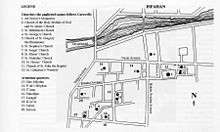
New Julfa was established in 1606 as an Armenian quarter by the edict of Shah Abbas I from the Safavid dynasty. Over 150,000 Armenians were moved there from the older Julfa (also known as Jugha or Juła) in Nakhichavan. Iranian sources state that the Armenians came to Iran fleeing the Ottoman Empire's persecution. Nevertheless, historical records indicate that the residents of Julfa were treated well by Shah Abbas in the hopes that their resettlement in Isfahan would be beneficial to Iran due to their knowledge of the silk trade.[1][2]
In 1947, the famous historian Fernand Braudel wrote that the Armenians had a trade network that stretched from Amsterdam to Manila in the Philippines. Many scholars in Armenia have done pioneering work on this network in the 60s, 70s and 80s. Levon Khachikian and Sushanik Khachikian have edited and published several New Julfan account books. Over the next few centuries, New Julfa became the hub of "one of the greatest trade networks of the early modern era,"[3] with outposts as far east as Canton, Surabaya, and Manila,[4] and as far west as Cadiz, London, and Amsterdam, with a few merchants traveling across the Atlantic or Pacific oceans to Acapulco or Mexico City.

A significant majority of Armenian trading families were based in New Julfa. Due to their dispersal, many families that were originally from the older city of Julfa[2][1][5] created a main settlement in Bengal expanding the trade network based in New Julfa.[1] However, Some scholars argue that Surat, Bengal and Hughli were independent nodes and that the central control of New Julfa was not as important to their thriving Indian Ocean trade.[4] Many New Julfan Armenians later settled in Manila, Hong Kong, and also in Australia. Their networks have been studied based on Armenian sources.[1][2] Not forgetting Singapore, where Armenians from New Julfa became the mainstay of the community. Most were traders, but perhaps better known were the Sarkies (Ter Woskanian) brothers who founded Singapore's iconic Raffles Hotel in 1887.
New Julfa is still an Armenian-populated area with an Armenian school and sixteen churches, including the Holy Savior Cathedral. Armenians in New Julfa observe Iranian law with regard to clothing, but retain a distinct Armenian language, identity, cuisine, and culture which is protected by the Iranian government.[6]
According to David Petrosyan of the Institute for Central Asian and Caucasian Studies, New Julfa had between 10,000–12,000 Armenian inhabitants in 1998.[7] As of today, it is still one of the world's largest ethnic Armenian quarters. The district is popular with young people in Isfahan, and is experiencing considerable growth compared to other districts of the city.
Sites
Churches
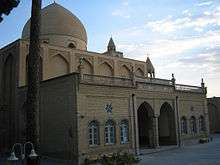
.jpg)
Armenian Apostolic
- Holy Savior Cathedral (Surp Amenaprgich, commonly known as the Vank) – 1655
- Saint Jacob Church (Surp Hakop) – 1607
- Saint George Church (Surp Gevork) – 1611
- Holy Mother of God Church (Surp Asdvadzadzin) – 1613
- Saint Stephen Church (Surp Stepanos) – 1614
- Saint John the Baptist Church (Surp Hovannes Mgrditch) – 1621
- Saint Catherine Nunnery (Surp Katarine) – 1623
- Holy Bethlehem Church (Surp Betłehem) – 1628
- Saint Nicholas Church (Surp Nikołayos Hayrapet) – 1630
- Church of Saint Gregory the Illuminator (Surp Grigor Lusavoritch) – 1633
- Saint Sarkis Church (Surp Sarkis) – 1659
- Saint Menas Church (Surp Minas) – 1659
- Saint Nerses Church (Surp Nerses) – 1666
Roman Catholic
- Holy Rosary Cathedral (Dominicans) – 1705
Protestant
- Saint Paul Church – 1875
Seventh-day Adventist
- Seventh-day Adventist Church – 1957
Assemblies of God
- Assemblies of God Church – 1965
Museums
- The museum of Khachatur Kesaratsi, in the compound of the Holy Savior Cathedral
Notable people

- Bogdan Saltanov (1630–1703), painter
- Alexander I of Julfa (d. 1714), catholicos
- Hagopdjan de Deritchan (d. 1726), diplomat
- Coja Petrus Uscan (1680–1751), merchant
- Marcara Avanchintz (17th century), merchant
- Shahamir Shahamirian (18th century), philosopher
- Ivan Lazarevich Lazarev (1735–1801), jeweler
- George Manook (1763–1827), merchant
- Hakob Hovnatanyan (1806–1871), painter
- Minus Megerdich Zorab (1833–1896), painter
- Mirza Malkam Khan (1833–1908), politician
- Vittoria Aganoor (1855–1910), poet
- Arathoon Stephen (1861–1927), businessman
- Diana Abgar (1859–1937), diplomat
- Mesrovb Jacob Seth (1871–1939), scholar
- Annik Shefrazian (1909/1910–1996), actress
- Sumbat Der Kiureghian (1913–1999), painter
- Alenush Terian (1920–2011), astronomer and physicist
- Krzysztof Penderecki (b. 1933), "Poland's greatest living composer"
- George Bournoutian (b. 1943), scholar
- Caro Lucas (1949–2010), scholar
- Masis Hambarsounian (b. 1950), boxer
- Hrant Markarian (b. 1958), politician and chairman of the Armenian Revolutionary Federation
- Aren Davoudi (b. 1986), basketball player
- Oshin Sahakian (b. 1986), basketball player
Gallery
- Entrance of the Holy Savior Cathedral.
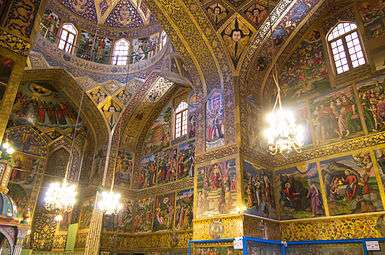 Inside the Holy Savior Cathedral.
Inside the Holy Savior Cathedral.- Armenian Genocide memorial,
New Julfa. 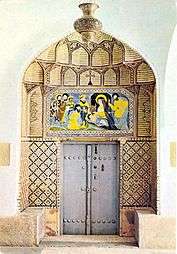
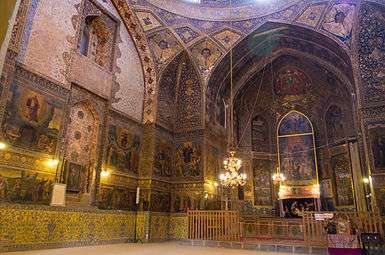 Inside the Holy Bethlehem Church.
Inside the Holy Bethlehem Church.
References
- 1 2 3 4 Sushil Chaudhuri and Kéram Kévonian eds., Les Arméniens dans le commerce asiatique au début de l’ere moderne [Armenians in Asian trade in the Early Modern Era], (Paris, 2007).
- 1 2 3 Baghdiantz McCabe, Ina The Shah’s Silk for Europe’s Silver: The Eurasian Silk trade of the Julfan Armenians in Safavid Iran and India (1590–1750). University of Pennsylvania Series, Scholar’s Press, 1999.
- ↑ Sebouh Aslanian. "The Salt in a Merchant's Letter": The Culture of Julfan Correspondence in the Indian Ocean and the Mediterranean. Journal of World History 19 (2008): 127-188
- 1 2 Bhattacharya, Bhaswatti “Making Money at the Blessed Place of Manilla: Armenians in the Madras- Manila Trade in the Eighteenth Century.” Journal of Global History, (2008),3, 1-20.
- ↑ Mesrob Jacob Seth, an Armenian historian
- ↑ Vasgen Ghougassian The Emergence of the Diocese of New Julfa in the Seventeenth Century, Atlanta, University of Pennsylvania Series), 1998.
- ↑ Petrosyan, David (1998). Армянская община в Иране (in Russian). Institute for Central Asian and Caucasian Studies.
...еще 10-12 тысяч - в Исфагане (армяне называют его Новой Джугой)...
Sources
- Gregorian, Vartan. “Minorities of Isphahan: The Armenian Community of Isphahan, 1587-1722.” Iranian Studies 7, no. 2 (1974), pp. 652–81.
- Aslanian, Sebouh (2011). From the Indian Ocean to the Mediterranean: The Global Trade Networks of Armenian Merchants from New Julfa. California: University of California Press. pp. 1–392. ISBN 978-0520947573.
External links
- Iran Chamber Society: Historical Churches of Iran
- Armeniapedia: Isfahan
- New Julda, To be..., directed by Arsen Gasparyan – Hayk Documentary Film Studio (Armenian)
- Julfa in Isfahan - Armenian Churches and Armenians in Iran (Video)
- Armeniapedia: Hin Jugha
- معماری کلیساهای اصفهان – فصلنامه فرهنگی پیمان (Persian)
See also
| Wikimedia Commons has media related to New Julfa. |
Coordinates: 32°38′10.79″N 51°39′20.55″E / 32.6363306°N 51.6557083°E

